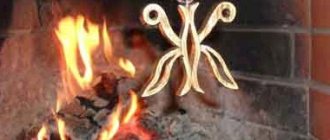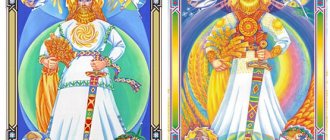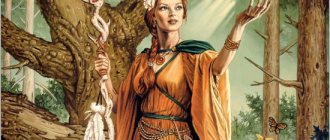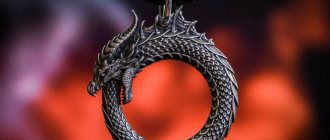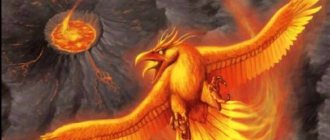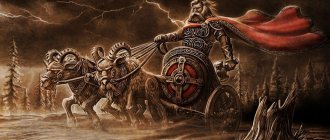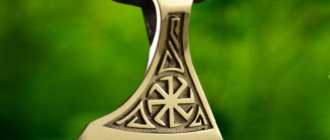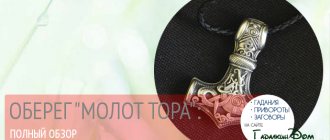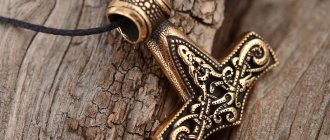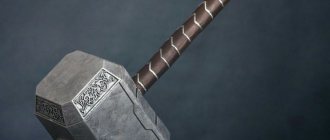What does the hammer amulet Mjolnir symbolize?
The amulet helped soldiers in battle, protected enemies from anger and hatred, and protected a person from all evil spirits. Later he became the patron saint of women, the god of abundance, and helped a woman get pregnant.
The meaning of the Thor's hammer amulet:
- gives the owner of the talisman confidence and courage;
- protects against natural disasters;
- helps those killed in battle to find peace;
- helps everyone who needs help;
- ensures victory (battles, deeds);
- helps to get rid of poverty, promotes the emergence of prosperity;
- increases fertility, protects livestock from death;
- affects fertility.
The hammer of the god Thor symbolizes destruction and creation. Thanks to these qualities, the amulet was used in rites and rituals that have the opposite meaning - life and death. It was believed that priests and sorcerers, with its help, established a magical connection with their patrons and could influence the destinies of people. The hammer was depicted on the weapons of the Vikings, Saxons, and Germans. They believed that Thor would help in battle and protect from death. Over time, ordinary people began to use it as an amulet.
The history of the appearance of the symbol in the form of a hammer
The history of the amulet Hammer of Svarog is closely connected with Slavic ideas about the creation of the world. In the beginning there was only Chaos, in which the god Rod appeared.
He created three worlds: for people, gods and the dead (respectively, Yav, Prav and Nav) and the god Svarog.
He hit the Alytyr stone with a hammer (which fell from the sky to the ground or, according to some sources, directly into the water, which is why the land was formed) and struck sparks from it.
You may be interested in: The meaning of the Alatyr amulet (the cross of Svarog) for men and women
These sparks became the first deities, who are also called Svarozhichi (Perun, Dazhdbog and some others). Also, from the sparks from the hammer, all life on earth was born.
Thus, the hammer is a reminder of the origins of all things and the power of the gods. So, wearing this amulet, a person seems to call on the power of the entire pantheon of Slavic gods to help him.
Meaning among the Slavs
In Viking times, the Mjolnir amulet was considered masculine; the image of the hammer was applied to various objects. The word Mjolnir is consonant with the word lightning, with which the Slavs associated the god Perun (god of thunder). According to the description, he looked like Thor. His weapon is an axe, which made them similar. It is believed that Perun is the prototype of Thor. Their weapons - a hammer and an ax - had one property: they destroyed enemies and protected them from dark forces.
Previously, the amulet was depicted separately, on a finished object or weapon, reminiscent of a Christian cross, which was considered an object in the fight against evil spirits.
The hammer was drawn disproportionately. There was a small handle and a huge firing pin. In ancient images of the instrument, the Thor was drawn in the form of a swastika, shifted to the left or right, or in the form of an inverted letter T with magical signs applied to it.
Appearance of Svarog's hammer
Svarog's hammer looks like a military weapon or a blacksmith's tool. The amulet is usually made of wood or metal. The hammer has 2 sides, each of which has a specific magical symbol: Alatyr and Svarozhich.
Alatyr is a Slavic rune (sometimes depicted as a symbol, it differs in design), meaning:
- the essence of everything, since the whole world was created from the Alatyr stone with a hammer according to Slavic beliefs;
- self-knowledge and self-understanding (also read as “Az”);
- Alatyr is also associated with an altar - a place of sacrifice to the gods, that is, alatyr represents the relationship between people and gods.
The Alatyr rune looks something like the ancient Greek letter “lambda”.
Rune alatyr
Also, instead of a rune, there may be an Alatyr symbol on the hammer (the cross of Svarog, an eight-pointed star).
The cross of Svarog is also depicted on the hammer
Svarozhich is a sign that resembles a somewhat complicated square swastika. He personifies Svarog himself and the divine fire that gives life (this is also a reference to the creation myth).
Swastika Svarozhich
Mythology
According to Scandinavian mythology, Thor was the son of the supreme god Odin and the earth mother Jord. He could fight evil and evil, harrow those living on Earth. According to legend, evil was personified by images of giants. The hammer smashed with incredible force, and when it flew, it became hot. To hold him, Thor had iron gloves.
In addition to destructive power, the amulet had creative power. His chariot was harnessed to two goats. According to one legend, Thor sacrifices one of the goats to feed the peasants. After collecting the remaining bones, he resurrects him. The Vikings used it to bless marriages and put it under the pillow to conceive and raise a healthy child.
Method of cleaning the amulet
There are two ways to cleanse an amulet.
The first and easiest way to clean the amulet will require running water and salt. It is necessary to keep the amulet under running water for 10 minutes and then place it in pure salt for a day. After the time has passed, rinse again under running water.
The fire cleansing ritual is also quite simple. When using fire, the use of salt is not necessary. The surface of the amulet must be heated or over a flame and then washed under port water.
Who needs to wear a talisman
The Thor's hammer talisman is suitable for men whose activities are related to military service, extreme sports, and weightlifters. His task is to protect from danger and help in difficult situations.
Women can wear a talisman if they have problems conceiving a child. It should be placed under the pillow, it will help you get pregnant and give birth to a healthy baby.
In ancient times, the hammer of the god Thor was applied to various objects (weapons, coins). To preserve the magical properties of the amulet, it cannot be worn for show. It cannot be combined with other amulets, especially those in the form of reptiles, as they weaken the effect. Store separately from other pendants and bracelets.
The best material for production is silver. Thanks to the properties of the metal, the effect of the amulet is enhanced. They use silhouettes of the ax of the god Thor, depicted on paper, wood, and metal, and hang them above the front door for protection from natural disasters. A photograph of the image can be hung on any wall in the house.
How does the hammer amulet work?
It is believed that such an amulet brings positive changes to the life of its owner: it instills self-confidence, helps strengthen family relationships, achieve certain goals, as well as heights in the career, drives away difficult thoughts and sets the mood for positivity.
You may be interested in: Slavic amulet Kolyadnik: The meaning of the symbol
Wearing the talisman Svarog's hammer brings into the wearer's life the wisdom of previous generations and contributes to the preservation of traditions in the family, which the Slavs attached special importance to.
BY THE WAY! In addition to personal protection, the amulet can perform the function of protecting the entire family from various troubles: from diseases to the evil eye.
Options for the amulet
A silver amulet is considered the most effective, but you can get a tattoo. The Thor hammer amulet is a male symbol and women are not allowed to get tattoos.
When making such an image, a man must approach it with full responsibility.
Hammer of the Thunderer Thor means:
- assistance in achieving goals, gaining wealth;
- the amulet will protect from evil and violence;
- make you strong and resilient;
- learn to make decisions on your own.
The hammer is depicted in two variations - the handle up or down, which is of great importance. In the lower position, the Thor amulet denotes strength, confidence, stability. The sign carries positive energy and helps in difficult matters. The opposite image speaks of the negative qualities of a person - aggressiveness, cunning. If, having made such a tattoo, a person was not inclined to such qualities, over time there will be character changes for the worse.
Do you need the help of magical powers?
Get an answer to your burning question from a magician and healer. Write about the problem right now, and an expert will suggest a solution online!
Ask a free question View all questions
The meaning of the Thurisaz rune depends on the image (up or down). Thor's amulet will have magical meaning if each line is clearly depicted. The third rune of the first etta is under the auspices of the power of fire. In the upright position it means moving forward, liberation from the past, gives self-confidence, brings wealth. Inverted - the emergence of danger, reluctance to do anything. Sometimes other symbols are depicted on Thor's hammer. It is color and black and white.
Images are made on the walls of the house, above the windows, to protect against natural disasters. The symbol is drawn in the form of an inverted letter T. More often, the artist outlines the tattoo on the arm; the size may vary.
Star of Rus' and hammer of Svarog
Quite often you can see that Svarog’s hammer is complemented by another sign - the star of Rus'. This symbol is also called the square or seal of Svarog.
It is a square into which 2 intersecting ellipses extending beyond it are inscribed.
The star has a fairly similar meaning to Svarog’s hammer: the harmonious relationship of all 3 worlds, harmony in family life, connection between generations, wisdom.
BY THE WAY! The combination of the symbols of the hammer of Svarog and the star of Rus' is considered optimal, since it enhances the effectiveness of the amulet many times over due to the fact that the amulet the hammer of Svarog and the star of Rus' applied to it have a similar meaning.
Do I need to charge Thor's hammer?
Any amulet needs to be cleaned and charged:
- rinse with clean (preferably spring water), can be left overnight;
- wipe, place in salt, leave for 2-3 hours;
- rinse again with water to remove salt;
- You can’t wipe it, it’s better to dry it over a candle flame;
- worn as a pectoral cross.
Contact with the body increases the effect of the god Thor's pendant. If the tattoo depicts a hammer, then contact with the skin is its charge. If worn as a decoration, then it is on the neck during the day and goes under the pillow at night. By following all the recommendations, the amulet will help in resolving life situations.
Comparative characteristics of the cults of Thor and Perun
1000 and the appearance of the Latin alphabet in Scandinavia, it is the runes that help us penetrate more deeply into the traditions and mythology of the Vikings.
Some scholars insist that in the etymology of the word “runa” there is an ancient Germanic root, from which the word “raunen”, which means to whisper, is derived in modern German. That is, the runes convey a secret message. They also refer to some Eddic poems, which list the magical virtues of powerful runes [10, p. 24]. The first futhark of runic writing had 24 icons. It was used from the very beginning until the end of the 9th century. The second Futhark appeared at the end of the 8th century, or perhaps at the beginning of the 9th century. The number of letters was reduced to 16. Rune stones are distributed throughout Scandinavia, where there are more than 6 thousand of them. About half of them date back to the 10th-12th centuries and are located in Sweden. About 620 monuments are located in Denmark and 602 rune stones in Norway. Finds have also been made outside Scandinavia. The study of the cult of Thor is also complemented by bracelets found in the Black Grave mound, on which runes are carved. Most of the Upland monuments were erected after the introduction of Christianity in Sweden, which is reflected in the texts and in the ornament of rune stones. Rune stones and Gotlandic steles, strictly synchronous with the Viking Age, set a coordinate system for orientation in the pagan worldview, embodied in later written monuments - the Elder Edda, skaldic poetry, the Younger Edda, sagas. One source is memorial stones common in Viking Age Scandinavia. The bulk of them are concentrated in Gotland - most often they were carved with scenes of the Einherim battles, Valhalla, as well as images of Thor's hammer - Mjolnir. Rock paintings in Southern Scandinavia depict a certain god (presumably Thor) with an ax or hammer, solar signs, as well as a goat, which was Thor’s animal [11, p. 16]. Using memorial stones, one can study and more fully characterize the cult of Thor among the ancient Scandinavians. The main material sources include archaeological finds in Old Scandinavian burial mounds. In 1880, a well-preserved ship was found in one of the Gokstad mounds in Vestfold. A small amount of jewelry was found in it. It dates back to 850. Silver figurines of animals and people were found in both mounds (they are believed to be figurines of gods). In addition to funeral ships, Viking burials are also sources, in which many things of a sacred nature were found. Tibla is a noble burial discovered in Upland (Sweden). The complex includes a chamber grave, looted, but swords, bronze belt plates remained, and buckles with images of the gods Odin, Thor and Frey were found. This burial dates back to the middle or end of the 6th century [4, p 45]. Many hammer amulets were also found, which symbolized the protection of Thor. Similar treasures have been discovered throughout ancient Scandinavia. The symbolism of bronze and silver amulets made in the 10th century is complex - some of them depict faces with round eyes or - apparently, people tried to depict the burning eyes of a god in this way, and sometimes the upper part of the hammer played the role of a beard. Such hammers are most often found not in graves, but in treasures that could have been an offering to God. In one cache in Torslev (Jutland) a silver bowl with an image of a hammer on the bottom was found (dating back to the 10th century) - it could have been used during rituals of worshiping Thor. Some of the decorated axes were ritual or special status indicators associated with Thor. A tomb with a wooden burial chamber, discovered in 1869 at Mammen, near Viborg (Denmark), contained the remains of a richly dressed man, at whose feet lay two axes - one iron, the other superbly decorated, with gold and silver inlays. It depicted the bearded face of the god Thor. Many such beautifully made axes were discovered in the burial mounds of Denmark, Sweden, Finland and northern Russia [10, p 34]. All of the above sources provide us with a huge layer of information for studying the Scandinavian god of thunder and lightning - Thor, and they are also of great value both for the archeology of Scandinavia and for literature, since the literary heritage of the ancient Scandinavians is unique in its complexity and beauty of style. 1.2 Review of sources on the cult of Perun
Perun is the only undeniable god in Slavic mythology, about whom the most documents and material sources have been preserved, undeniable in their authenticity. First of all, let us remember the most important evidence about Perun among the Russians and Western Slavs. Direct evidence of the veneration of the god Perun in Rus' during paganism is the chronicle of Nestor, treaties between the Russians and Byzantium in 907, 945, 971, the Novgorod Chronicle, the Galician text from 1302. Among the written sources of Czechoslovak antiquity, no text mentioning Perun has yet been discovered. Some mythologists are content to merely point to two Slovak songs recorded by the enthusiastic Slavophile Kolor. These songs mention Buoh'eParom'e. In the dictionary of the Slovak language there is the verb “peruntati” - to crack, the adjective “perunsky”, and also several spells with the name Parom, Peron (Parondotebe, Peronovastrelat'azabila) [8, c 4]. The Polish king Vladimir banned the folk custom of maintaining the eternal flame of Perun (Pioruna), whose name is now used by the Poles in the sense of “thunder”. Here you can also find local names dedicated to Perun. The fact that the Baltic Slavs also called the thunder god by the same name is evident from the names perendan, which fully corresponds to the German Donnerstag. The testimony of Procopius in the 6th century about the cult of the thunderer among the southern Slavs is quite classic and undeniable: “The Slavs recognize only one ruler of this universe, one god, the creator of lightning” [5, p. 59]. Another source and evidence of the cult of Perun among the Bulgarians is the history of the Bulgarian hieroschemamonk Spiridon - he is unknowingly the first Bulgarian folklorist. He mentions that in the 18th century, when he lived in Bulgaria, Perun was still revered and honored during times of rainlessness. Spiridon understands by the name Perun not only the raincoat himself, but also the thunderer - this is clear from the explanation by Father Spiridon himself: “lightning or Perun”[13, p. 51]. The cult of Perun can also be traced by topographical names, as well as how strong an influence it had on people who, in honor of Perun, named their children after him (the names Perun, Perunka, etc.). The spread of the name Perun among Russians by many scientists is explained by its mention in the Nestor Chronicle, during the rewriting of which this name allegedly passed into books, and only then into legends. Such an explanation can in no way be applied to the South Slavic lands and dialects, where one can hardly speak of any influence of the Nestorian Chronicle. Most of the personal names, topographical and other similar names, from Istria to the White and Black Seas, cannot be explained in any other way than by the fact that they are evidence surviving from the time of the pagan cult of Perun among the southern Slavs [2, p. 46]. Also, material sources that have been well preserved to this day are the temples and idols of Perun, which are located throughout the territory inhabited by the ancient Slavic peoples. They remained due to the fact that after the baptism of Rus', the Slavs would secretly worship Perun for some time, not following the order of Prince Vladimir to destroy the idols and temples [12, p 73]. Thanks to the above sources, modern researchers of the cult of Perun have the opportunity to study it in full, as far as they are preserved. The number of sources would have increased significantly if Christianity, through various persecutions, sermons and writings, had not gradually destroyed pagan traditions, or had not mixed and renamed them.
CHAPTER
II .
CHARACTERISTICS OF THE THUNDER GODS. THEIR FUNCTIONS 2.1 God Thor
Thor (Donar) is the ancient German god of thunder, storms and fertility, the “thrice-born” eldest son of Odin and the earth goddess Jord, the son of Odin and Fjörgyn, as well as Odin and Frigg. In Scandinavian mythology, God is the protector of the worlds of gods and people from giants and dangerous monsters [9, p. 124]. It is believed that the Roman historian Tacitus mentions Donar under the name of Hercules, describing the religion of the Germans. The German mercenaries, having adopted the Roman system of attributing the days of the week to one or another deity, gave Donar Thursday - the day of Jupiter. This may indicate similarities between Jupiter, the establisher and guarantor of world order in Roman mythology, and Donar, as well as the high status of both gods in the eyes of Germanic warriors. In the “Speeches of the High One” it is said: “He is the strongest of all gods and people.” His domain is called Trudvangar (Fields of Power), and his palace is called Bilskirnir (Indestructible). There are five hundred chambers in this palace and forty more. It is larger than all the houses that people have ever built [7, p 164]. Thor's attributes: hammer Mjollnir. Frost giants and mountain giants feel the hammer as soon as it is raised. The hammer of the aesir Thor was not only the main weapon for protecting gods and people from the ancient forces of darkness and chaos, but also an absolutely necessary ritual item for the aesir. The second attribute is the Belt of Strength. As soon as he girds himself with it, the divine power will double. His third treasure is iron gauntlets to hold his hammer. God lives in Asgard - the world of the gods. The chambers of Thor are called Trudheim. Thor was represented as a red, bearded strongman with the hammer Mjolnir in his hand. The hammer was originally thought to be stone, then iron. This is an indispensable attribute of Thor, like the spear of Odin or the sword of Tyr. Thor was also called Eku-Tor, that is, “Thor with a chariot.” A chariot was any cart with two wheels instead of four, and driven by two animals [6, p. 73]. Thor is the god of warriors - defenders, “people's militias,” but he was also revered as a heavenly god - the thunderer, who sends rain to the earth, and was prayed for the blessing of the harvest. Thor was called the “thunderer” and it was believed that when thunder roars, it is he who rides across the sky in his chariot, and lightning flying from heaven to earth is Thor’s hammer. Thor rides in a cart pulled by two goats. The names of the goats - Tangniostr and Tangrisnir ("Gnashing of Teeth" and "Grinding of Teeth") allude to the gnashing of teeth and the roar of a thunderstorm itself. At the same time, goats have always been associated with lust and therefore fertility, that is, with the cult of fertility. For Thor, goats are not only mounts, but also a source of food. Thor eats the animals for dinner, and in the morning they are whole again and can run [11, p. 190]. Thor in Scandinavian mythology is primarily concerned with protecting Midgard (the world of people) and Asgard (the world of gods) from the Jotuns - giants from Utgrad (the world of giants). Thor was called: “the enemy and destroyer of giants and giantesses” (Appendix 1.1). Most stories related to Thor tell of his travels to Utgard and his heroic exploits there. As it is said in the Younger Edda: “...he traveled a lot, traveled halfway around the world and alone defeated all the berserkers, all the giants, the largest dragon and many animals.” And “great strength and power were given to him. Therefore he conquers all living things” [15, p. 46]. Thor was a warrior and a hero, and stories about his clashes with people have not reached us. Perhaps because people are too weak compared to the red-bearded god, they are not his rivals and especially do not encroach (at least they did not encroach before) on the foundations of the world order, unlike terrible monsters. Thanks to this circumstance, Thor is considered an ally and assistant of people in their struggle and confrontation with both direct enemies and the “forces of darkness.” Thor was perceived as the protector of human families and clans, as well as the developed land belonging to them. Thor, with his name as a symbol, could bless the fate of an individual person. In Ragnarok - the Death of the World (or the twilight of the gods) Thor fights with the serpent Jormungandr, kills him, but also dies himself, poisoned by the bites of the serpent (Appendix 1.2) At the end of the Viking Age, the “red-bearded Red Thor” becomes the main opponent of the White Christ, a god from the South. The red color of Thor was associated with fierce will, passion, strength, and the white color of Christ was associated with kindness, justice, and compliance. In fact, the supporters of Christ in Scandinavia propagated their faith with no less ferocity than the pagans defended theirs. There were also rumors that Thor offered Christ a mortal duel, but Christ refused (“The Saga of Njal”) [14, p. 203]. So, we see that Thor, with all his strength and military prowess, is not an aggressor, but a defender of Asgard and Midgard. Thor is a peace-loving, friendly and good-natured god. He only unleashes his anger when those under his care are in danger. He is a friend and protector of people. So, the god Thor: the god of thunder and lightning, the patron of farmers and cultivators, the guardian of the balance of good and evil in the world, the protector of Midgard and Asgard (the world of people and the world of gods), the patron of marriages.
2.2 God Perun
Perun is the god of thunder and lightning, the patron saint of warriors. Son of the god Svarog and Lada the Mother of God. During the birth of Perun, the earth in the area shook, lightning flashed in the sky, thunder rumbled, welcoming the birth of the son of Svarog Perun the Thunderer [2, p. 17]. Perun - Heavenly Warrior, leader of the heavenly army, the highest patron of the entire military class. With his lightning arrows he creates the seed of the Earth, and also drives all the undead away from the world. In his heavenly watch, Perun vigilantly guards the borders of his native land. He is the protector god, the keeper of all order, order and law, the holder of power and the guardian of justice. He teaches his warriors to be faithful to duty and value honor above their own lives. His Element is Thunderstorm. His constant companions are iron and fire. The earth shakes from the blows of his thunder club. In addition to fire, Perun is closely associated with the cult of water, wood and stone. According to the Slavs, on the warm days of spring, Perun, with his lightning, fertilized the earth with rain and brought the sun out from behind the clouds. He is considered the ancestor of heavenly fire, which, descending to earth, gives life. With his creative power nature awakened to life, and he seemed to be creating the World again. Hence Perun is a producer, a creator. At the same time, Perun is a formidable and punishing deity; his appearance excites fear and trembling. Perun also had control over the elements of nature and some areas of people’s lives [13, p34]. Perun also acts as a guardian of order in the world. He pursues evil forces and creatures of chaos - those who violate harmony. Lightning is the reflection from the blows of Perunov’s sword, with which he strikes the Heavenly Serpent. After all, Perun’s main duty is to protect the Sun, which the heavenly Serpent wants to steal. The deity’s weapons are a “thunder arrow” or “devil’s finger” (belemnite stones), a spear - lightning, a sword, a saber, an ax or a club (Appendix 2.1). According to some legends, Perun’s lightning is of two kinds: lilac-blue - “dead”, striking to death, and golden - “living”, creating, awakening earthly fertility [1, p. 46]. Perun moves across the sky on his chariot drawn by horses, on his horse or on the wheel of Perun (the “thunder sign” or a wheel with six spokes). In folk legends, Perun is represented as a horseman galloping through the skies on a horse or riding a chariot drawn by winged stallions, white and black. People mistook the roar from the chariot for peals of thunder. When Perun throws stones and arrows on the ground, a thunderstorm arises (Appendix 2.2). Our ancestors believed that Warriors who died in battle ended up in Perun’s army. Perun - Father and progenitor of the Slavs, was depicted as a middle-aged Warrior with black and silver hair and a fiery golden swirling beard. Perun's hair was likened to a thundercloud. Perun was also imagined as a middle-aged, angry man with a red, swirling beard. Perun was surrounded by birds sitting on the branches of the World Tree. Perun carries a quiver of arrows in his left hand, and a bow in his right hand; the arrow he shoots hits the enemy and causes fires. He was also revered as the ruler of rain clouds and earthly water sources, including springs that break through the earth after a lightning strike [5, p. 69]. Perun, walking around the world, willingly takes on the appearance of the forest bull Tura. The flower of Perun is considered to be the blue iris (six lilac-blue petals, thunder sign). Trees of Perun: oak, hornbeam. Perun's bird is an eagle.[2, p. 126]. So, Perun, the eldest son of the god Svarog: the god of thunder and lightning, heavenly fire, the patron of warriors and the princely squad, the steward god, the god who punishes for non-fulfillment of laws, the protector of Reveal (Earth), the giver of male strength.
2.3 Similarities and differences
As we see, the Scandinavian Thor and the Slavic Perun are very similar in their functions, but according to myths they have different births and attributes of their power. Now let's look at the similarities and differences separately. Thor and Perun perform almost lonely functions: they are, first of all, the gods of thunder and thunder. On the one hand, there are furious thunderstorms and thunder, which indicate that the gods are angry, that they are coming to restore order or protect the World from enemies. But on the other hand, this is a fertilizing thunderstorm, this is a blessed rain, thanks to which people will reap a good harvest. That is, both gods are the personification of the Stormy Sky and are also considered gods of fertility. These gods are the protectors of the world who monitor the balance of good and evil in it. With their formidable weapons, they kill enemies and are guardians of order, protecting the world from chaos, which is under constant threat from giants (Thor) and chthonic monsters. Both Thor and Perun are similar in appearance - they were represented as middle-aged men with a red, swirling beard. A red beard is an indispensable feature of the God of Thunder among a variety of peoples. They also both have magical weapons that give them extra strength, since it is never said that they can throw lightning without it. Both gods ride across the sky in their chariots, going on urgent business to preserve the peace, and these chariots make a noise that people call thunder. But, despite all these similarities, these gods, at first glance so similar to each other, also have many differences that strictly delimit the sphere of activity of these gods. First of all, the main difference between Perun and Thor is that the first is the head of the pantheon, the main god-almighty. And Thor is the second god in his pantheon, that is, he has less responsibility than Perun. In addition, this difference suggests that in Scandinavian mythology, the previously standing supreme god of thunder and thunder was supplanted by the god of war - Odin, but in Slavic mythology this god remained in the same place, which indicates a different mentality, worldview and values among the ancient Slavs and the ancient Scandinavians. The second important difference is that Perun is immortal, and Thor is destined to fall at the End of the World, that is, Thor is mortal. To this difference we can add the fact that Perun overcame his enemy the serpent and saved the world from destruction, and Thor fell from his poison, without having completed his main mission. At the end of the pagan period, the development of local cults led to the fact that the ancient figure of God, the creator of lightning, was supplanted by others. In Scandinavia, the god of war, Odin, took the leading place. Only in Russia, as we see, Peryn remained the main god of both the people and the Varangian squad led by the prince. Thor was revered by farmers and people's militias. Having analyzed the characteristics and functions of the thunder gods of the Scandinavian Thor and Slavic Perun, we can conclude that their figures are similar to each other, but at the same time they are very different from each other in important details that immediately catch the eye . By comparing these two gods, one can see how different the Old Scandinavian and Slavic peoples are in their vision of divine greatness and power, but at the same time, the similarity of their main functions should be noted.
CHAPTER
III .
FEATURES OF REVERENCE OF THE THUNDER CULTS 3.1 Places of worship
The cult of Perun has been known for a very long time, although some scientists attribute its wide spread among the Slavs only to the 8th-9th centuries. There is no news of pagan temples in the chronicles. However, archaeological excavations provide some insight into what East Slavic pagan sanctuaries looked like. They were usually located on the top of a hill or in a large clearing in a forested swampy area and were a flat, rounded area, sometimes with a slightly raised middle or, conversely, with a funnel-shaped depression in the center. Perun's temple should have been located in an elevated place - on a hill or mountain, but not in a lowland. The Cap itself could be carved from stone, oak or elm, but not from spruce or aspen. In height, Perunova Kap could not be lower than an adult husband who raised his hands, since it is unbecoming for a person to look at the image of God from top to bottom. In front of Kapu lay an altar stone or stood an oak sacrificial log. Around the Temple, plowing could be carried out, or a palisade could be erected, or six or eight cleansing fires could be laid out. The sacred fireplace inside the Temple itself could be either one - in front of the sacred face, or four - on the four cardinal points around the Kapi. On Perun's Day, in front of the entrance to the Temple, a purifying Fire Gate could also be installed, built from two vertically standing pillars with a crossbar, tied with tarred tow and solemnly lit, so that everyone passing through them would bow to the ground to God. The site was surrounded by one or two ditches and low ramparts. The places where idols were worshiped were called “temples” (from the Old Slavonic “kap” - image, idol); where sacrifices (requirements) were made - “treasuries” (Appendix 3.1). Perun's sanctuaries are set up in the open air. They are shaped like a flower; in those sanctuaries that have been excavated by archaeologists, there are usually eight “petals”, but in ancient times, according to scientists, there were six. “Petals” were pits in which unquenchable sacred fires burned. A sculpture of Perun is placed in the middle. An altar is placed in front of the image of God, usually in the form of a stone ring. Offerings were placed there, sacrificial blood was shed: most often animal blood, and if the people were threatened with serious misfortune, then human blood. The symbolism of the temple is an oak idol, a stone or two stones on either side of the idol, a sacrificial fire lit in front of the idol, a six-rayed wheel on the idol, a symbol of lightning or an arrow, or even a thunder arrow itself near the idol. Probably, the pagans did not cut down living trees for idols - a living, but old, powerful oak was already a symbol of worship for them, having painted facial features on it with gold and silver paint. Oak struck by lightning was especially revered and amulets, staves, wands, arrows made from it were considered the best guardians from Navi [12, p 43]. The legend about the sacred Perunov Hill has been passed down from generation to generation. Sanctuary in Peryn. After 983, an idol of Perun was placed here. The sanctuary was located on the island of Peryn (the left bank of the Volkhov River at its source from Lake Ilmen), in
PERUN - military hypostasis - RUEVIT
Finally, Perun - he is just heavenly fire! In one of the dialects of the ancient language, “Pyrrha” means fire. Fire "Pyrrhus" in Latin. Perun’s consciousness preserves the world of dense matter. Perun, as you remember, is a guardian warrior, the potential of the gravitational fields of all manifested reality. As you can see, from the information bank or physical vacuum to dense manifested matter there are only 7 steps. Hence the sacred number “7”. Radegast is one of the names of Perun. Everything material remains with Perun. Perun is the keeper of matter, which is why he has a military form - Ruevita.
Thor: characteristics, marital status, heritage
The Norse god Thor, being the son of Odin, was in all likelihood the second most important in the Old Norse pantheon. At the same time, in some regions he was revered as the god of fertility. In the Eddic sagas, the god Thor is described as a red-bearded (or blond-haired) hero with a violent temper and monstrous strength. Thor is hot-tempered, indefatigable in food and the art of war, in fact, the traditional archetype of the Viking warrior.
The wife of the god Thor was the beautiful Sif, the goddess of fertility and prosperity, who subsequently received golden hair to replace those that Loki cut off for her at the instigation of Freya (see the corresponding myth from the Younger Edda). Sif and the thunder god Thor had two children - the beautiful Trud (or Froud, probably a Valkyrie) and Modi (the patron of the battle, after Ragnarok he will be one of the surviving aces).
However, according to Sturluson’s “Younger Edda,” Modi was not given birth to Sif at all, but to the giantess Yarnsaxa, who also gave birth to Thor and another son, Magni, a mighty warrior who saved his father in the battle with Hrungnir, and after Thor’s death managed to pick up Mjolnir and survived Ragnarok . Also in the “Younger Edda” Snorri Sturluson mentions a certain daughter of the Viking god Thor and the goddess Sif named Luridi, about whom nothing is known. The early Eddic sagas mention a stepson of Thor (son of Sif) named Ull, a master of archery, and a certain adoptive mother of the god of thunder, Chlora, about whom no explanatory information has also been preserved (she is mentioned only in Sturluson’s “The Language of Poetry”).
But the thunder god Thor is famous not only for his great descendants, who will eventually turn out to be one of the few aces who managed to survive the “death of the gods” in order to build the world anew together with people. Thor and his wife Sif rule the kingdom of Trudheim ("house of power" in Old Norse) or Trudvang ("field of power"), although it is unclear whether these names refer to the same place, which appear in different sources. It is important to note that the euhemeric version of the Elder Edda says that Thor (no longer as a mythological, but a very real historical character) conquered Thrace, “which we call Trudheim.”
The “Speeches of Grimnir” (the song of the “Elder Edda”) says that the thunder god Thor lived in Bilshirnir (literally “rattle of lightning” from Old Norse), this is the most beautiful house in all of Asgard, it has 540 rooms, each of which gods live.

